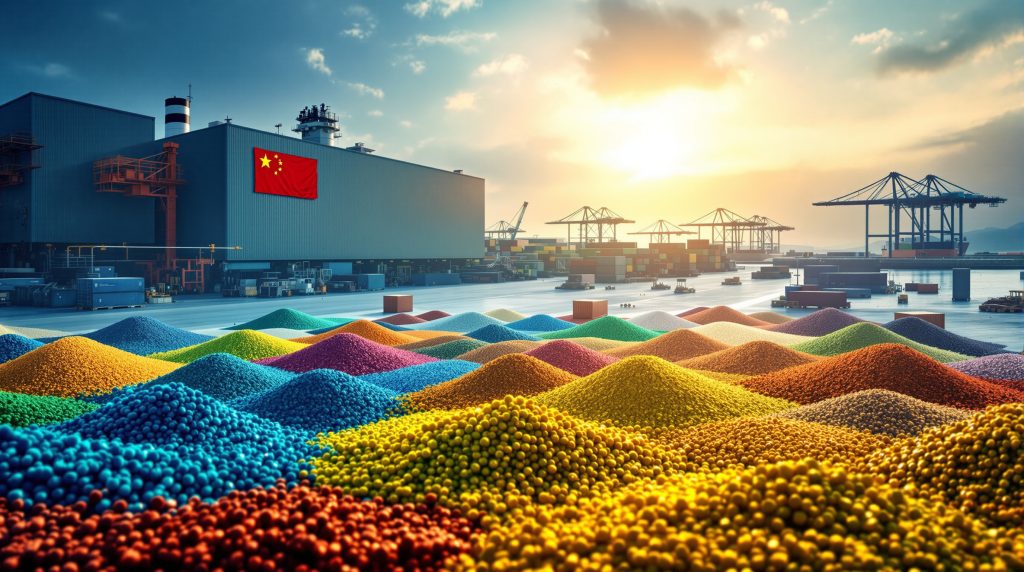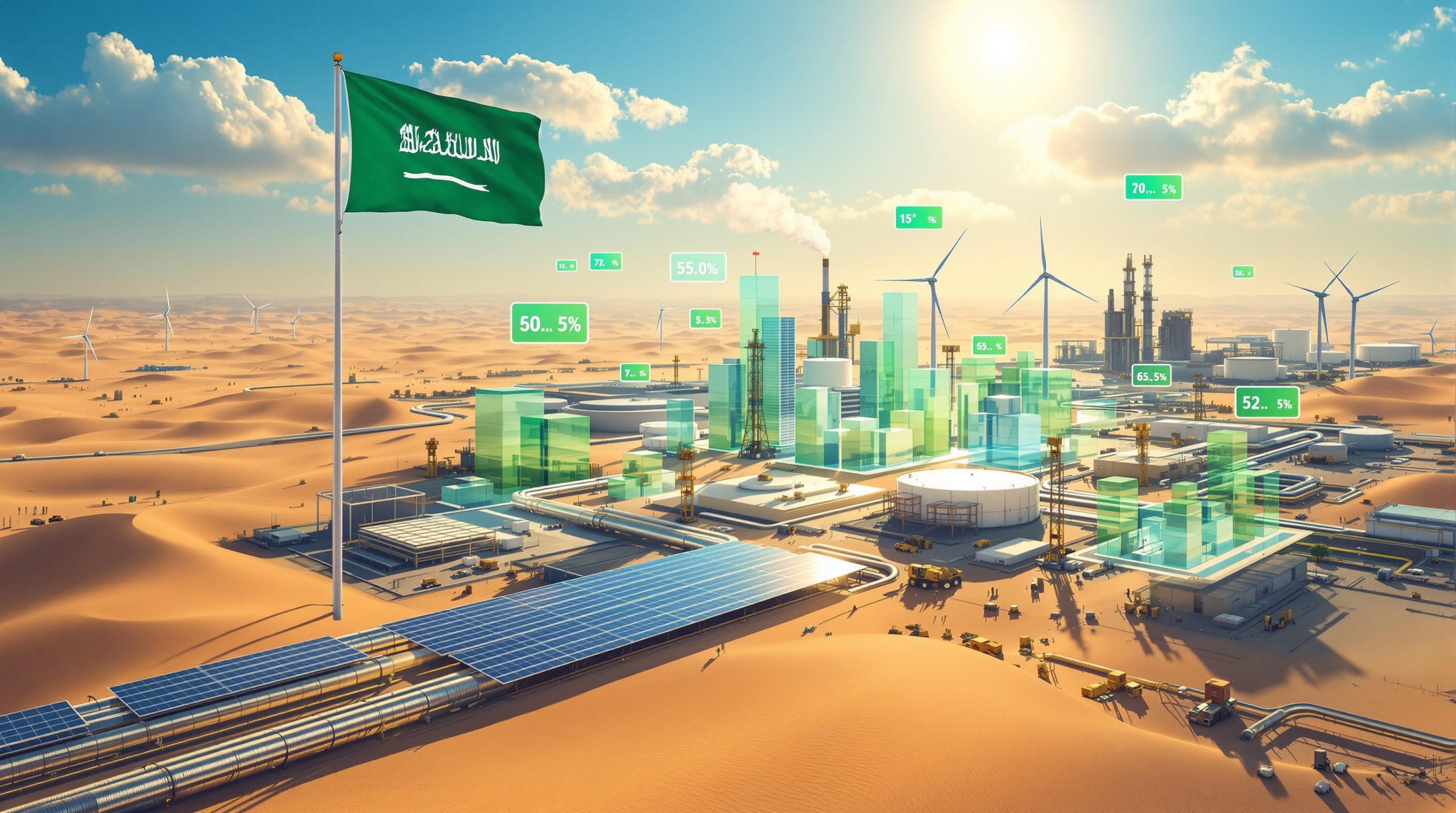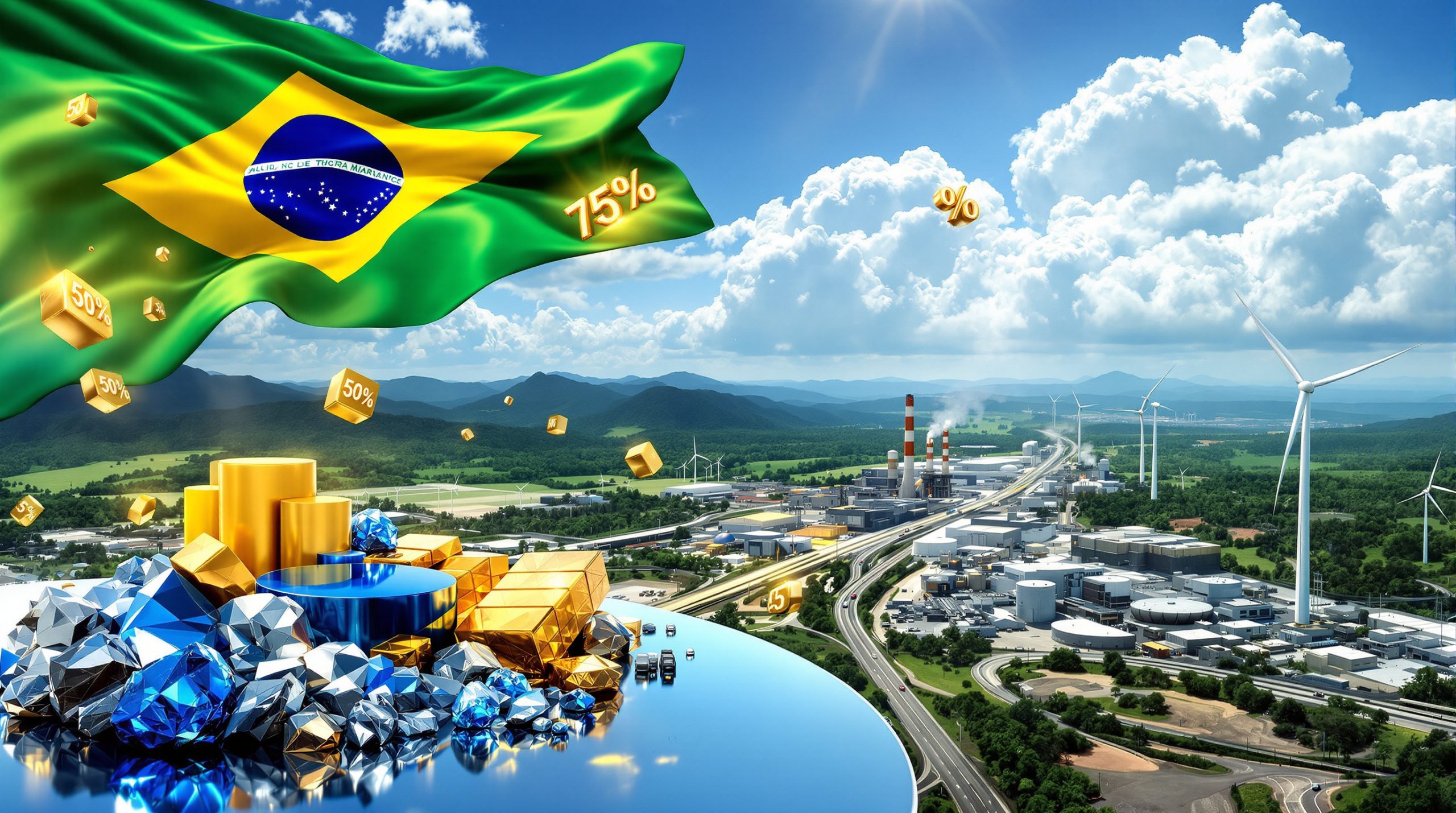How Has China's Rare Earth Export Strategy Evolved in 2025?
China's rare earth export landscape has undergone significant transformation throughout 2025, characterized by dramatic policy shifts and market fluctuations. The year began with stringent export controls on refined materials, followed by a surprising mid-year surge in export volumes that reshaped global supply chains.
Strategic Export Restrictions Implemented
April 2025 marked a critical turning point with China's implementation of a mandatory export licensing system specifically targeting medium and heavy rare earth elements. This regulatory framework imposed targeted restrictions on critical materials including samarium, gadolinium, terbium, dysprosium, lutetium, scandium, and yttrium – elements essential for advanced technology manufacturing.
The controls strategically focused on high-value refined products where China held maximum leverage: specialized alloys, permanent magnets, and chemical mixtures with applications in defense and renewable energy sectors. Industry analysts noted the strategic timing of these restrictions coincided precisely with heightened trade tensions between China and Western economies.
According to the U.S. Geological Survey 2024 Mineral Commodity Summaries, China produced approximately 210,000 metric tons of rare earth oxides in 2023, representing about 70% of global production – giving these export controls significant global impact.
Unexpected Mid-Year Export Surge
In a surprising policy reversal, August 2025 saw Chinese rare earth exports skyrocket to approximately 7,400 tons – the highest monthly volume recorded since 2012 according to Mining.com. This dramatic shift caught markets off-guard, especially considering first-half 2025 exports had already increased by approximately 12% compared to the same period in 2024.
Most notably, rare earth magnet exports jumped nearly 75% month-over-month in July 2025, signaling a substantial policy shift. Behind the scenes, diplomatic agreements reached in June 2025 between China, the United States, and European nations facilitated this easing of restrictions.
The export surge proved particularly timely, helping calm fears of supply shortages that had driven price speculation across multiple industrial sectors. This pattern of restriction followed by strategic relaxation demonstrates China's sophisticated approach to leveraging its rare earth dominance for maximum economic and diplomatic advantage.
What Drives China's Rare Earth Market Dominance?
China's commanding position in the global rare earth supply chain stems from multiple strategic advantages that have been cultivated over decades through careful planning and substantial investment.
Unparalleled Supply Chain Control
China maintains 70-85% of global rare earth mining production capacity according to multiple industry reports. However, its true dominance extends far beyond raw materials. The country controls approximately 85-95% of global processing and refining capacity – the critical chokepoint in rare earth supply chains.
According to the U.S. Geological Survey, China possesses about 44 million metric tons of rare earth reserves, representing approximately 37% of verified global reserves as of 2025. This raw material advantage is amplified by the country's strategic stockpiles, which function both as a buffer against market fluctuations and as powerful policy leverage in international relations.
The concentration of technical expertise in rare earth processing represents another crucial advantage. China has invested decades in developing specialized knowledge in separation techniques, especially for heavy rare earths with the highest strategic value.
Dual-Direction Trade Flows
A lesser-known aspect of China's commodity strategies involves its sophisticated management of both import and export flows:
| Activity | Volume (2024-2025) | Key Partners | Strategic Significance |
|---|---|---|---|
| Exports | 7,400 tons (Aug 2025 peak) | Japan (34%), US (17.7%), Germany | Refined, high-value products |
| Imports | ~129,500 tons (2024) | Myanmar, Malaysia, Laos | Raw materials for processing |
This dual-direction approach allows China to maintain processing dominance while conserving domestic resources. By importing raw materials from neighboring countries and exporting value-added products, China maximizes economic returns while extending the lifespan of its own reserves.
Vertical Integration Advantages
China's rare earth industry benefits from comprehensive integration across the entire value chain – from mining through processing to manufacturing of end-use products. This structure enables coordinated planning that independent producers struggle to match.
Advanced processing technologies developed through decades of sustained investment provide significant cost and efficiency advantages. The established infrastructure for handling environmentally challenging extraction processes represents another barrier to competition from nations with stricter environmental regulations.
Strategic coordination between state-owned enterprises and private companies allows China to pursue national objectives while maintaining market responsiveness – a hybrid approach that optimizes both economic and strategic outcomes.
Why Are Rare Earth Elements Critical to Global Industries?
The strategic importance of rare earth elements extends far beyond their relative scarcity, with their unique properties making them indispensable across multiple high-tech sectors.
Essential Applications in Advanced Technologies
Rare earth elements play critical roles in numerous technologies that define modern life:
-
Permanent magnets: Neodymium-iron-boron (NdFeB) and samarium-cobalt (SmCo) magnets power electric vehicle motors and wind turbine generators, providing unmatched power-to-weight ratios essential for energy efficiency.
-
Precision optics: Rare earth elements enable lasers, fiber optics, and high-performance glass used in everything from telecommunications to medical equipment.
-
Catalytic applications: These elements serve as catalysts for petroleum refining and automotive emissions control systems, significantly reducing environmental impact.
-
Display technologies: Phosphors containing europium, terbium and other rare earths deliver the vibrant colors in smartphones, computers, and television screens.
-
Defense systems: Critical components in radar systems, guidance systems, and communication equipment rely on rare earth elements for their unique electronic properties.
The 17 rare earth elements, despite their name, aren't particularly rare in Earth's crust. However, they rarely occur in concentrated deposits and require sophisticated processing to separate them, making economically viable production challenging.
Green Technology Dependencies
The transition to renewable energy and transportation electrification has dramatically increased demand for specific rare earth elements:
-
Wind turbines using permanent magnet generators require substantial quantities of neodymium, praseodymium, dysprosium, and terbium for high-performance magnets that can function reliably for decades.
-
Catalytic converters and emissions reduction systems depend on lanthanum and cerium to function effectively.
-
Energy-efficient lighting technologies utilize europium, terbium, and yttrium to produce specific light wavelengths while minimizing energy consumption.
-
Next-generation battery technologies being developed to complement lithium-ion systems frequently incorporate rare earth elements to improve performance characteristics.
This dependency creates a paradox: green technologies designed to reduce environmental impact rely on materials with significant extraction and processing challenges.
Defense and National Security Applications
Military applications represent some of the most strategically sensitive uses of rare earth elements:
-
Precision-guided munitions rely on rare earth components for guidance systems and sensors.
-
Advanced radar and sonar systems require specialized materials with unique electromagnetic properties.
-
Night vision equipment utilizes rare earth phosphors to amplify limited light.
-
Communications equipment across military platforms incorporates numerous rare earth-containing components.
-
Modern aircraft and naval vessels include dozens of systems dependent on rare earth elements for optimal performance.
This dependency creates significant national security implications, particularly when supply chains are concentrated in potentially adversarial nations.
How Have Global Markets Responded to China's Export Fluctuations?
The volatility in China's rare earth export policies has triggered significant ripple effects across global markets and supply chains, forcing adaptation strategies across multiple industries.
Price Volatility and Market Uncertainty
The market impact of China's export policies has been profound:
-
Spot prices for key rare earth oxides experienced 30-45% fluctuations during policy shift periods in 2025, with dysprosium oxide and terbium oxide seeing the most dramatic movements.
-
Forward contracts and futures markets showed increased hedging activity as manufacturers sought to mitigate supply risks.
-
Price premiums emerged for non-Chinese sources despite quality and consistency challenges, reflecting the market's willingness to pay for supply security.
-
Market uncertainty contributed to stockpiling behavior among major consumers, further amplifying price volatility.
The impact varied significantly by element, with heavy rare earths used in permanent magnets experiencing the greatest price fluctuations due to their critical applications and limited substitution possibilities.
Supply Chain Adaptation Strategies
Industries dependent on rare earth materials have implemented diverse adaptation strategies:
-
Japanese manufacturers accelerated recycling programs and material substitution research, building on decades of efforts to reduce dependency following previous Chinese export restrictions.
-
European industrial consumers diversified supply sources despite higher costs, prioritizing supply security over price optimization.
-
U.S. defense contractors increased inventory buffers of critical materials to insulate military programs from short-term supply disruptions.
-
Technology companies redesigned components to reduce dependency on the most restricted elements, particularly dysprosium and terbium.
These adaptations highlight the tension between optimal engineering solutions and supply chain security considerations, forcing compromises that impact cost structures and performance characteristics.
Investment Patterns in Alternative Sources
Capital flows have responded to perceived supply risks:
-
Capital inflows to rare earth mining projects outside China accelerated by 40% in 2025 as investors recognized the strategic opportunity.
-
Australia, Canada, and the United States saw significant investment in processing capabilities – the critical missing link in non-Chinese supply chains.
-
Recycling technologies attracted venture capital and corporate investment as a complementary approach to primary mining.
-
Research into synthetic substitutes for critical applications gained momentum, particularly for permanent magnet applications.
These investments reflect a fundamental market recalibration, recognizing that price alone is insufficient to guide strategic resource allocation when geopolitical factors introduce significant non-market risks.
What Political and Diplomatic Factors Influence China's Export Decisions?
China's rare earth export policies represent a complex interplay of economic interests, geopolitical strategy, and diplomatic leverage carefully calibrated to advance national objectives.
Trade Negotiation Leverage
The strategic timing of export policy shifts reveals their use as diplomatic tools:
-
The timing of export restrictions and relaxations aligns with broader trade discussions, creating pressure points in negotiations.
-
The scheduled call between President Xi and US President Donald Trump preceding August's export surge demonstrates the use of rare earth policy as a signaling mechanism.
-
Selective licensing creates pressure points in strategic industries without triggering WTO violations that might prompt formal complaints.
-
Differential treatment of trading partners based on diplomatic relations and concessions allows China to reward cooperative behavior while maintaining pressure on adversarial relationships.
This approach allows China to extract concessions in unrelated areas by leveraging dependency on rare earth materials – a powerful form of asymmetric leverage.
Environmental Policy Considerations
Environmental justifications provide legitimate policy cover while serving strategic interests:
-
Environmental protection is increasingly cited as justification for production controls, aligning with broader national goals.
-
Consolidation of mining operations to improve environmental compliance and oversight reduces illegal production that undermines strategic control.
-
Gradual shift toward higher environmental standards in processing facilities addresses legitimate ecological concerns while raising barriers to new market entrants.
-
Integration of rare earth policies with broader green development initiatives creates policy coherence that strengthens China's international environmental credentials.
These environmental considerations represent both genuine concerns and convenient justifications for production controls that serve multiple objectives simultaneously.
Domestic Industrial Policy Alignment
Rare earth export policies support broader industrial development goals:
-
Export controls support domestic value-added manufacturing by ensuring preferential access to critical materials.
-
Chinese manufacturers receive preferential access to rare earth materials, providing competitive advantages in global markets.
-
Strategic reserves management is coordinated with industrial development goals to support priority sectors.
-
Support for domestic innovation in applications and substitution technologies ensures Chinese industry maintains technological leadership.
This domestic-international policy alignment demonstrates sophisticated coordination across multiple government agencies and economic sectors, maximizing strategic advantage from rare earth resources.
How Are Global Powers Responding to China's Rare Earth Strategy?
Major economies have implemented multi-faceted strategies to address vulnerabilities exposed by China's rare earth export controls, with varying approaches reflecting different industrial bases and resource endowments.
United States Strategic Initiatives
The U.S. response combines regulatory, financial, and security approaches:
-
The Defense Production Act has been invoked to support domestic rare earth development, designating these materials as strategically vital to national security.
-
Federal funding for processing facilities and separation technologies aims to rebuild domestic capabilities that eroded during decades of Chinese market dominance.
-
Strategic stockpile expansion focuses on defense-critical elements, prioritizing materials with the greatest supply vulnerability and military significance.
-
Trade policy coordination with allies seeks to diversify supply chains while maintaining access to Chinese materials in the near term.
-
Research funding for recycling and substitution technologies addresses long-term dependency through technological innovation.
These initiatives represent a significant shift from market-driven approaches to strategic intervention, acknowledging the national security implications of rare earth supply chains. The recent US critical minerals order further reinforces this strategic focus.
European Union Collective Response
The EU has pursued a coordinated approach across member states:
-
Implementation of the Critical Raw Materials Act accelerated in 2025, providing a regulatory framework for securing strategic materials.
-
Coordinated procurement approaches help secure supplies from non-Chinese sources by aggregating demand across European industries.
-
Investment in domestic recycling infrastructure and technologies leverages Europe's manufacturing base to create circular material flows.
-
Research funding for material efficiency and substitution builds on Europe's strong scientific and engineering capabilities.
-
Strategic partnerships with Australia, Canada, and African nations diversify supply sources while addressing sustainability concerns.
This approach balances immediate supply security with longer-term sustainability objectives, reflecting Europe's environmental priorities and limited domestic resource base.
Japan's Advanced Mitigation Strategy
Japan's longstanding recognition of rare earth vulnerability has produced the most mature response strategy:
-
Long-term investments in recycling technologies are now showing commercial results, with urban mining facilities recovering significant quantities of rare earths.
-
Urban mining initiatives recovering rare earths from electronic waste demonstrate viable circular economy approaches to critical materials.
-
Deep-sea exploration for rare earth deposits in exclusive economic zones offers potential long-term domestic supply sources.
-
Material science research has yielded promising substitutes for some applications, reducing dependency on the most vulnerable supply chains.
-
Strategic stockpiling programs maintain approximately 5-year supply of critical materials, providing substantial insulation from short-term disruptions.
Japan's approach demonstrates the benefits of sustained, systematic responses to resource vulnerability, providing a model for other nations with similar challenges.
What Are the Future Trends in Global Rare Earth Supply Chains?
The rare earth market is undergoing structural transformation as global responses to China's market dominance take effect, creating both challenges and opportunities across the supply chain.
Emerging Alternative Supply Sources
The global supply landscape is diversifying:
-
Australia's production capacity is expanding by approximately 25% between 2024-2026, led by Lynas Rare Earths' Mount Weld operation and emerging projects.
-
U.S. domestic production is restarting with the Mountain Pass mine reaching full capacity after years of intermittent operation.
-
Canadian projects are advancing toward commercial production, with particular focus on heavy rare earth deposits.
-
African deposits are attracting significant development investment, particularly in countries with stable mining regulations.
-
Brazilian reserves are being reevaluated for commercial viability as higher market prices improve project economics.
These developments suggest a gradual but significant diversification of global supply, though processing capabilities remain a critical bottleneck outside China.
Technological Innovations Reshaping Demand
Technology evolution is altering the demand profile for specific elements:
-
Advanced magnet technologies are reducing dysprosium requirements by up to 30% through improved manufacturing processes and grain boundary diffusion techniques.
-
Alternative motor designs including switched reluctance and synchronous reluctance technologies are decreasing overall rare earth content in some applications.
-
Recycling efficiencies have improved recovery rates to over 90% for some applications, creating significant secondary supply sources.
-
Substitution technologies are reducing dependency on most constrained elements, particularly in applications where performance requirements allow flexibility.
-
Circular economy approaches are extending the useful life of rare earth-containing products through remanufacturing and repurposing.
These innovations reduce pressure on primary supply while creating new value streams in recycling and materials recovery sectors. Recent rare earth breakthrough technologies are further accelerating this trend.
Evolving Market Structures and Pricing Mechanisms
Market institutions are adapting to increased awareness of rare earth strategic importance:
-
More transparent pricing benchmarks and indices are developing to support contract structures and financial instruments.
-
Futures markets for key rare earth elements are emerging to facilitate price risk management and discovery.
-
Long-term supply contracts are becoming industry standard as both producers and consumers seek stability.
-
Risk-sharing arrangements between producers and consumers are developing to support capital investment in new production.
-
Premium pricing for environmentally and socially responsible sources is emerging as ESG considerations influence procurement decisions.
These market structure evolutions reflect the maturing of rare earth markets from opaque, relationship-based trading toward more sophisticated commodity market mechanisms.
How Can Investors Navigate Rare Earth Market Opportunities?
The strategic importance and volatility of rare earth markets create distinct investment considerations across the value chain, requiring specialized knowledge and risk assessment frameworks.
Mining and Processing Investment Considerations
Primary production investments face unique challenges:
-
Project feasibility depends heavily on processing capabilities, not just resource size, as separation technology determines economic viability.
-
Regulatory approvals have become increasingly complex due to environmental considerations, particularly for deposits containing radioactive elements.
-
Capital intensity requires patient investment horizons, with development timelines frequently exceeding five years from discovery to production.
-
Strategic partnerships are often necessary for market access and technical expertise, particularly for junior mining companies.
-
Political risk assessment is critical for project evaluation as governments increasingly view rare earth resources through a national security lens.
These factors create significant barriers to entry but also potential competitive advantages for projects that successfully navigate these complexities.
Downstream Manufacturing Exposure
Component manufacturers face both risks and opportunities:
-
Companies with rare earth dependencies are experiencing margin pressures as input costs fluctuate unpredictably.
-
Supply chain resilience has become a competitive advantage, allowing prepared firms to maintain production during supply disruptions.
-
Vertical integration strategies are gaining traction among larger players seeking to secure critical material inputs.
-
Innovation leaders reducing material intensity are gaining market share as customers prioritize supply security.
-
Regional manufacturing shifts are following supply security considerations, creating new industrial clusters near secure supply sources.
These dynamics are reshaping competitive landscapes across multiple industries, creating winners and losers based on adaptation capabilities.
Strategic Metals Investment Vehicles
Financial market participants have developed specialized approaches:
-
Specialized ETFs provide exposure to the rare earth value chain while diversifying single-project risk.
-
Junior mining companies offer leveraged exposure to price movements but require careful due diligence regarding technical and financial capabilities.
-
Recycling technology firms present an alternative investment angle with potentially lower geopolitical risk.
-
Major diversified miners are selectively reentering the sector after previous disappointments, bringing financial strength and technical expertise.
-
Private equity investments in processing and separation technologies target the highest-value segments of the supply chain.
These investment vehicles offer varying risk-reward profiles, allowing investors to calibrate exposure based on their market outlook and risk tolerance.
What Are the Environmental Implications of Rare Earth Production?
The environmental footprint of rare earth production presents both challenges and opportunities for sustainable development, with significant implications for industry structure and competitive dynamics.
Environmental Challenges in Traditional Production
Conventional production methods create substantial ecological impacts:
-
Radioactive thorium and uranium often present in rare earth deposits create long-term waste management challenges.
-
Acid leaching processes generate hazardous waste streams requiring sophisticated containment and treatment.
-
High water consumption in conventional processing methods creates conflicts in water-stressed regions.
-
Energy-intensive separation and purification processes contribute significantly to carbon footprints.
-
Tailings management presents long-term environmental liabilities that persist long after mining operations cease.
These environmental challenges have historically been externalized, particularly in regions with limited regulatory oversight, creating artificial cost advantages for less responsible producers.
Sustainable Production Innovations
Technological innovation is addressing environmental challenges:
-
In-situ leaching technologies reduce surface disturbance by extracting rare earths underground without traditional mining.
-
Closed-loop processing systems minimize waste discharge by continuously recycling process chemicals.
-
Renewable energy integration reduces carbon footprints, particularly important for energy-intensive separation processes.
-
Bioleaching approaches using microorganisms to extract rare earths are showing promise in pilot projects.
-
Improved tailings management and remediation techniques reduce long-term environmental liabilities.
These innovations may ultimately reshape industry economics by internalizing environmental costs that were previously externalized, potentially altering competitive dynamics between producers.
Recycling and Circular Economy Approaches
Secondary production streams offer complementary supply sources:
-
Urban mining recovers rare earths from electronic waste, creating material flows that bypass primary extraction entirely.
-
End-of-life wind turbine recycling programs are capturing magnet materials that contain significant quantities of neodymium and dysprosium.
-
Design-for-recycling principles improve recovery economics by facilitating material separation and reuse.
-
Industrial symbiosis creates value from manufacturing waste streams that contain recoverable rare earth content.
-
Advanced separation technologies enable economic recycling at smaller scales, supporting distributed recovery operations.
These approaches create positive environmental outcomes while developing more resilient supply chains that are less vulnerable to geopolitical disruption. The critical minerals energy transition highlights the importance of sustainable rare earth supplies for renewable energy development.
FAQ: China's Rare Earth Export Dynamics
What are rare earth elements and why are they important?
Rare earth elements comprise 17 metallic elements that, despite their name, are relatively abundant in Earth's crust but rarely found in concentrated, economically viable deposits. Their unique magnetic, luminescent, and electrochemical properties make them essential components in technologies ranging from smartphones and electric vehicles to military systems and renewable energy infrastructure.
The distinction between light and heavy rare earths is particularly important, with heavy rare earths like dysprosium and terbium being scarcer and more valuable due to their critical applications in permanent magnets and other high-tech uses.
Why does China dominate the global rare earth market?
China's dominance stems from decades of strategic investment in mining, processing capabilities, and technical expertise. The country recognized the strategic value of rare earths early, developing comprehensive capabilities across the entire value chain while maintaining cost advantages through scale, integration, and historically less stringent environmental regulations.
This dominance wasn't accidental but resulted from systematic policy implementation beginning in the 1980s when China identified rare earths as a strategic sector. By controlling approximately 70% of global production and 85-95% of processing capacity, China has leveraged this resource advantage into industrial and geopolitical influence.
How do China's export restrictions impact global industries?
Export restrictions create supply uncertainties and price volatility for industries dependent on rare earth materials. This affects manufacturing costs, product development timelines, and strategic planning across automotive, electronics, renewable energy, and defense sectors. Companies must invest in supply chain resilience, alternative sourcing, and potential redesigns to mitigate these impacts.
The effects cascade through supply chains, with immediate price impacts followed by longer-term structural adjustments including reshoring, recycling initiatives, and material substitution research. The US‑China trade war impact extends far beyond the rare earth market itself, affecting downstream industries with combined market values in the trillions.
What alternatives exist to Chinese rare earth supplies?
Emerging alternatives include expanded production from Australia's Mount Weld and Nolans projects, the revitalized Mountain Pass operation in the United States, and developing projects in Canada, Africa, and South America. Additionally, recycling, urban mining, and material substitution technologies are advancing as complementary approaches to diversify supply sources.
Processing capacity represents the critical bottleneck, as mining capacity outside China has grown faster than separation and refining capabilities. Investments in processing technology and facilities are essential to creating viable alternative supply chains, requiring capital commitments with multi-year development timelines.
How sustainable is rare earth production?
Traditional rare earth production has significant environmental challenges, including radioactive waste management, acid leaching impacts, and high water and energy consumption. However, new processing technologies, stricter environmental standards, and circular economy approaches are improving sustainability. The environmental footprint must be balanced against the critical role these materials play in enabling green technologies like wind turbines and electric vehicles.
This creates a sustainability paradox: rare earths are essential for renewable energy technologies that reduce carbon emissions, yet their extraction and processing can create significant environmental impacts. Resolving this tension requires both technological innovation and regulatory frameworks that incentivize responsible production.
Ready to Capitalise on the Next Major Mineral Discovery?
Stay ahead of market trends with Discovery Alert's proprietary Discovery IQ model, which instantly notifies investors of significant ASX mineral discoveries like those in the rare earth sector. Visit the dedicated discoveries page to see how historic discoveries have generated substantial returns for early investors.




